Testing methodologies play a pivotal role in shaping the decisions of businesses in the world of experimentation and optimization. One such testing approach is the A/A test, a technique that might seem counterintuitive at first glance but holds significant value in ensuring the accuracy and reliability of testing environments. In this article, we will discuss in depth the nuances of A/A testing, its purpose, implementation, and the impact it can have on experimentation outcomes.
The Full Picture of Web Optimization Testing
If you are a business owner or a marketer, you should know how to analyze your work progress and what methods work best with your business to reach your audience and accomplish your desired end. However, it is not possible to determine the best marketing campaign, for example, without having a base that helps you to make business-related decisions. This base should be clear, accurate, and correct data to analyze and determine your next step and decision accordingly. Here come A/B tests to help marketers with their decision-making and understanding of their website performance, thus, their business performance.
However, what if the A/B testing tool you are using is not accurate? Or was it not used or reconfigured properly? This would lead to inaccurate results and inadequate action. This crucial problem has led to the creation of A/A Testing and uncovered the need for this test. So, what is an A/A test? What is it for? Does it have disadvantages?
Here, we provided a detailed guide to A/A testing revealing answers and concerns about it. Let us dig deep.
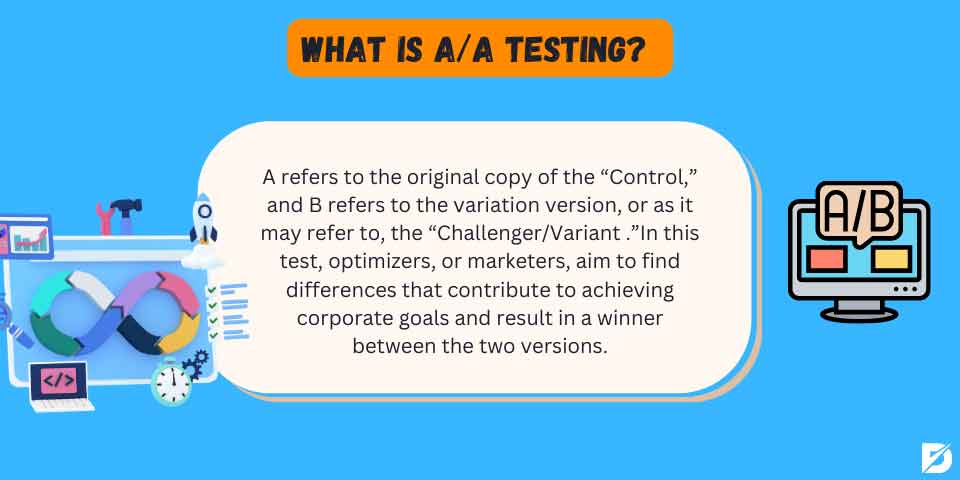
What Is A/A Testing?
To understand what A/A testing is, it is better to explain what A/B testing means first. A/B testing is basically randomly experimenting on a web page, email, campaign, advertisement, etc., and its variant copy. Clearly, A refers to the original copy of the “Control,” and B refers to the variation version, or as it may refer to, the “Challenger/Variant .”In this test, optimizers, or marketers, aim to find differences that contribute to achieving corporate goals and result in a winner between the two versions. Check the digital marketing tools you can use here.
How Is the A/B Test Done?
The marketers split the target audience into two groups. One group will be directed to version A, while the other will be to version B. Then, the traffic will be analyzed depending on visitors’ behavior toward each version. It is crucial to mention here that the two groups of visitors have to be identical in numbers, and this has to be tested over a certain known and defined period of time. Determining time and size is also essential, as each case or company may require different terms.
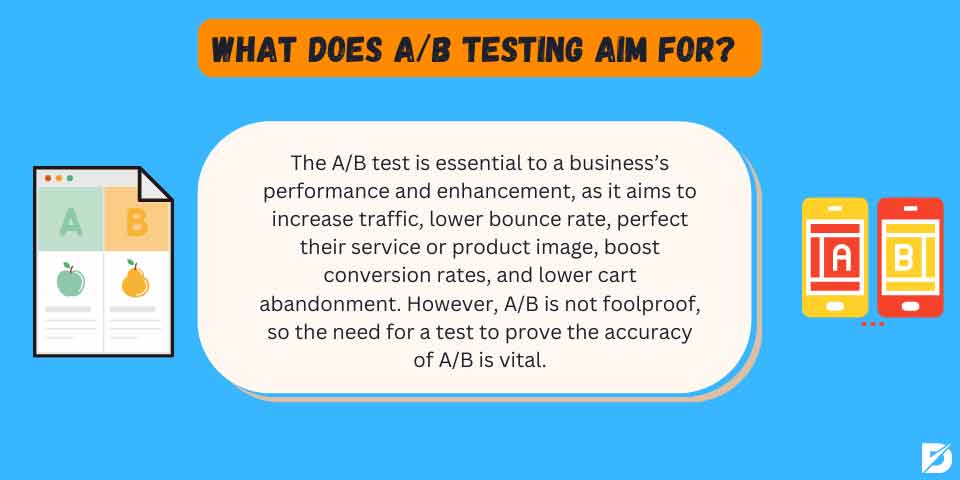
What Does A/B Testing Aim for?
During the testing, the marketers will test visitor behaviors toward each version to check which page successfully creates visitors’ leads. Pointing out the differences that may contribute to having a winning version is the primary purpose of an A/B test.
By doing so, marketers will be able to finalize the best way to design their website to deliver their content and the purpose of their business correctly and conveniently. For example, if changing the font color or size, moving some CTA buttons from the left side to the right or from the bottom of the page to the top will contribute to increasing the number of visitors who would actually click to register, subscribe or even purchase, then, these changes should be permanent.
Hence, the A/B test is essential to a business’s performance and enhancement, as it aims to increase traffic, lower bounce rate, perfect their service or product image, boost conversion rates, and lower cart abandonment. However, A/B is not foolproof, so the need for a test to prove the accuracy of A/B is vital. Such a test is a/a which is a test of a test.
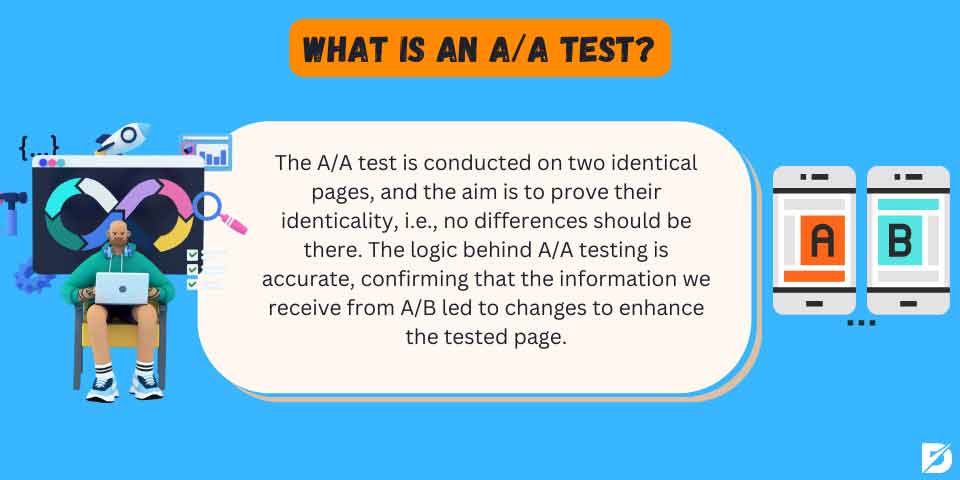
So, What Is an A/A Test?
Unlike the A/B test, the A/A test is conducted on two identical pages, and the aim is to prove their identicality, i.e., no differences should be there.
We can say that the logic behind A/A testing is accurate, confirming that the information we receive from A/B led to changes to enhance the tested page. Therefore, a/a tests the winner version and its exact duplicate on two or more groups of people. The expected KPI, Key Performance Indicators, should be the same for all the groups. However, if the test results in a new winner, it proves the inaccuracy of A/B test results. Hence, it failed.
For example, suppose 15% of group A, the visitors of the control, subscribe to the newsletters. In that case, we must expect to receive the same percentage for the same action from group B, the visitors of the Variant, which is the identical copy of the Control. In case, the number of subscribers differs, it means the test has failed.
How Does A/A Test Differ Than A/B Test?
As mentioned above, A/B tests two different versions, or two pages with different contents, whereas A/A tests the efficiency of the winning copy resulting from the A/B test. In other words, compare two identical pages with identical contents. Learn more about effective marketing strategies.
Another significant difference is the sample size, A/A requires a notably larger sample size than A/B testing does, and due to its large sample size, it takes much longer time to complete.
What Is the Process for an A/A Test?
Even though how to do the A/A testing depends on many factors, such as the software tools you use to do the test, the steps, and the uses, we can say that conducting an A/A test is almost the same in all cases.
The steps for A/A testing are provided below.
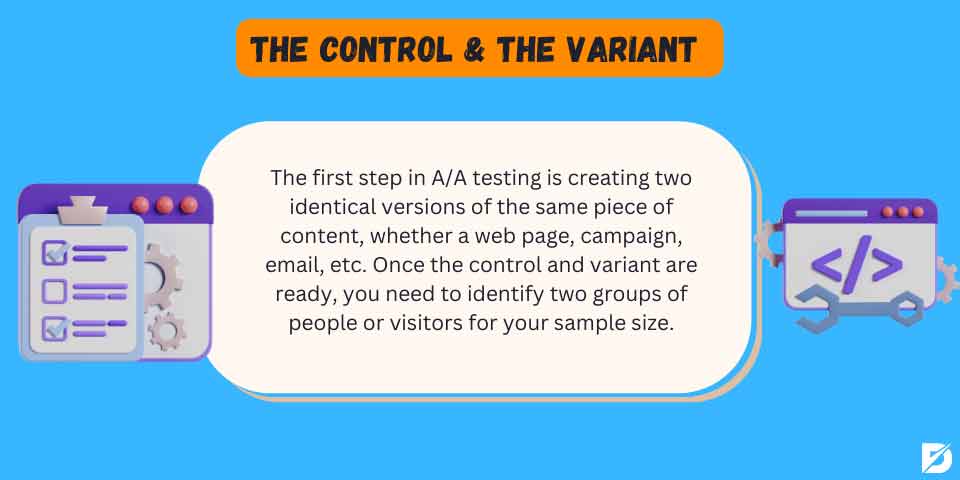
The Control & The Variant
The first step in A/A testing is creating two identical versions of the same piece of content, whether a web page, campaign, email, etc. Once the control and variant are ready, you need to identify two groups of people or visitors for your sample size.
Again, the sample size for both groups must be the same.
Key Performance Indicator
Once your control and variant are ready with their groups of visitors, you must identify the KPI. The KPI measures the performance of a specific action over a defined period of time. For example, you may identify your KPI as the number of visitors who subscribes to the newsletter.
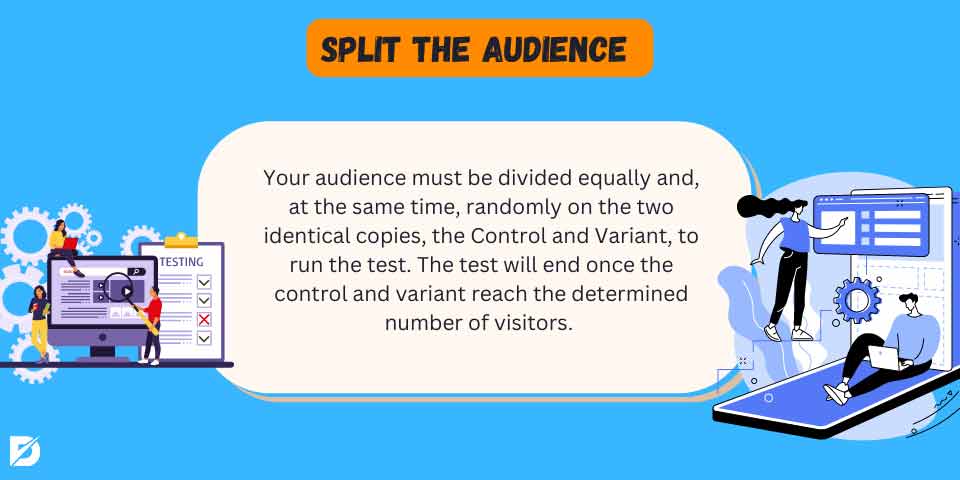
Split the Audience
In this step, your audience must be divided equally and, at the same time, randomly on the two identical copies, the Control and Variant, to run the test. The test will end once the control and variant reach the determined number of visitors.
KPI Check
At this final step, you need to check your KPI. Since the control and variant are identical, the KPI for both groups must match. There should not be any discrepancies, differences, or a winner version.
The Need to Conduct an A/A Test
A/A test is usually done for the two reasons below.
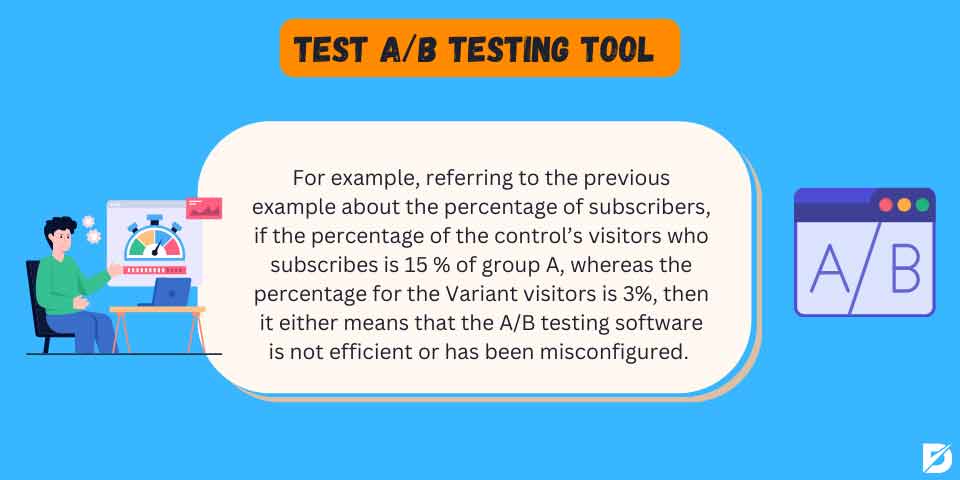
Test A/B Testing Tool
This might be the first and most important use for A/A tests. Companies use the A/A test when they have a new software tool for A/B or updating or reconfiguring a current one.
Its primary purpose here is to confirm the accuracy of A/B tests. For example, referring to the previous example about the percentage of subscribers, if the percentage of the control’s visitors who subscribes is 15 % of group A, whereas the percentage for the Variant visitors is 3%, then it either means that the A/B testing software is not efficient or has been misconfigured.
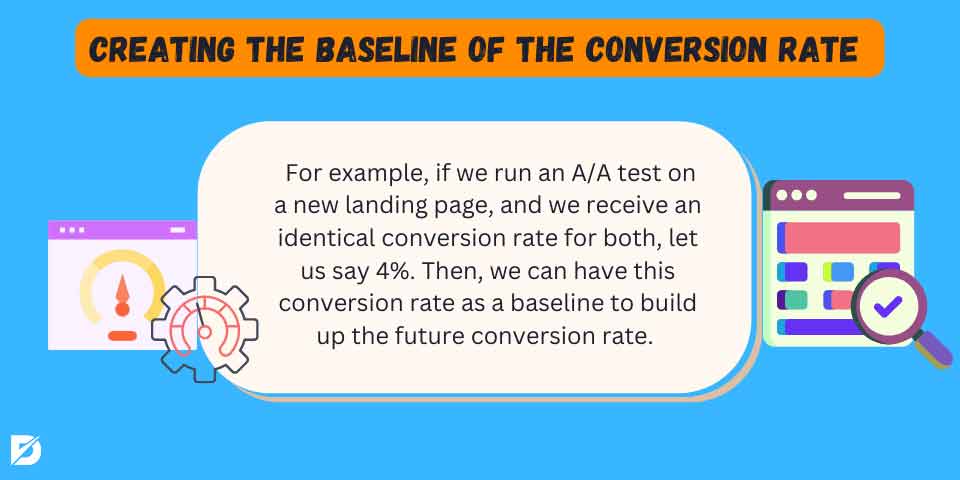
Creating the Baseline of the Conversion Rate
Another use for A/A tests is determining a baseline for measurement, such as conversion rate, which refers to the percentage of visitors who actually responded to CTA from the total number of visitors. Check what is eCommerce conversion rate here. For example, if we run an A/A test on a new landing page, and we receive an identical conversion rate for both, let us say 4%. Then, we can have this conversion rate as a baseline to build up the future conversion rate.
As a result, creating a new version of this landing page in the future must result in a significantly higher conversion rate.
It is crucial to point out that small differences noticed during the testing between the two identical versions. Also, the final result may show a tiny difference in the conversion rate. For example, the conversion rate of the Control may be 4%, whereas the conversion rate for the Variant is 4.02%. This result does not mean we should consider it a significant statistic. Therefore, there are no biases or discrepancies detected.
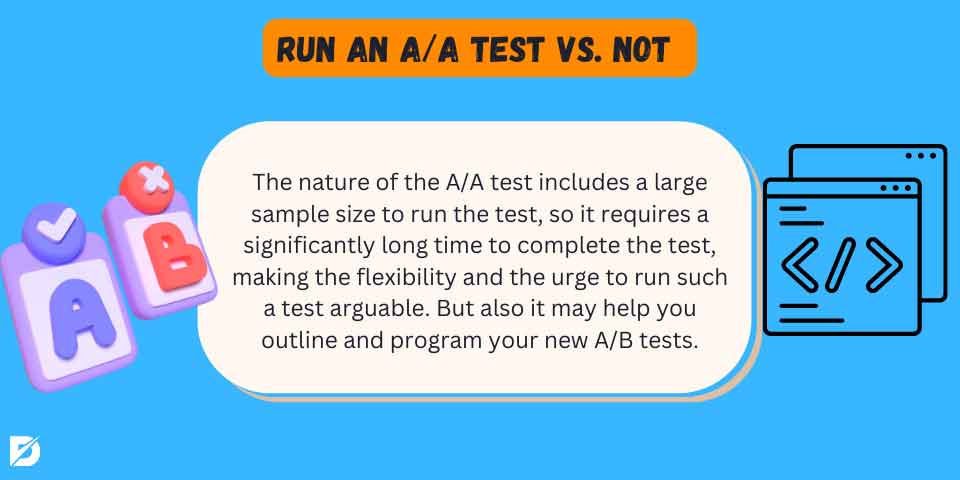
Run an A/A Test Vs. Not
The big question is, “Does it worth running an A/A test?”
The nature of the A/A test includes a large sample size to run the test, so it requires a significantly long time to complete the test, making the flexibility and the urge to run such a test arguable. As plenty of more valuable testing or actions may be conducted during the significantly long period of time that the A/A test takes. So, why the waste of time and effort?
However, A/A tests are helpful and come in handy if you need to test the reliability and efficiency of the new A/B testing software.
Also, it may help you outline and program your new A/B tests. Depending on your data benchmarks and any discrepancies you found in your data, you may prepare a successful A/B test.
Nonetheless, even with its utility, A/A tests must be conducted rarely. Due to its time-consuming, it will not be efficient to run it every time a new change or tiny amendment occurs on your landing page or running a new campaign. Check the digital marketing strategies that might be helpful.
So, does this mean an A/A test has no benefits?
The Benefits of an A.A Test
The A/A test can be time-consuming, but it does not mean it has not got any benefits. We have stated what we believe are the main benefits of A/A tests are below:
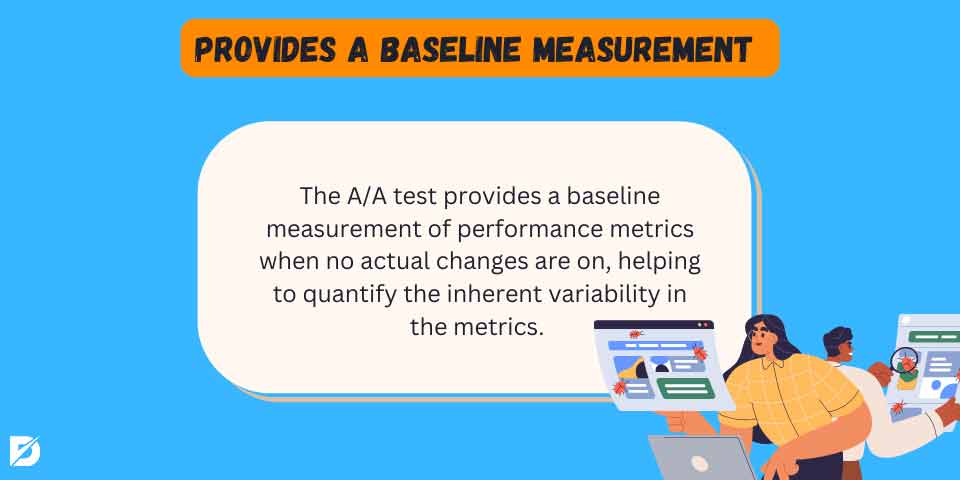
- Provides a Baseline Measurement
The A/A test provides a baseline measurement of performance metrics when no actual changes are on, helping to quantify the inherent variability in the metrics.
- Evaluate The Quality of Data
The A/A test allows companies and enterprises to evaluate the quality and accuracy of the collected data, ensuring that the metrics are being tracked correctly.
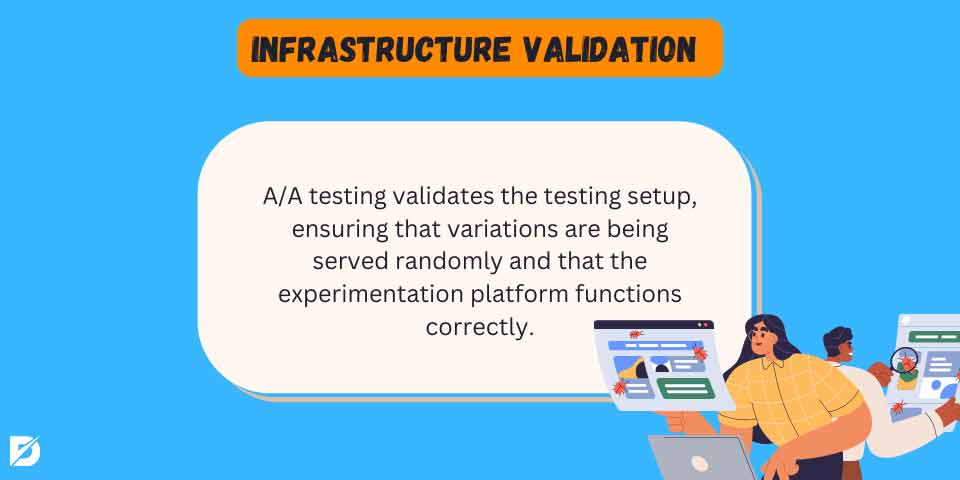
- Infrastructure Validation
A/A testing validates the testing setup, ensuring that variations are being served randomly and that the experimentation platform functions correctly.
Challenges Associated with A.A Testing
Some challenges with A/A testing include:
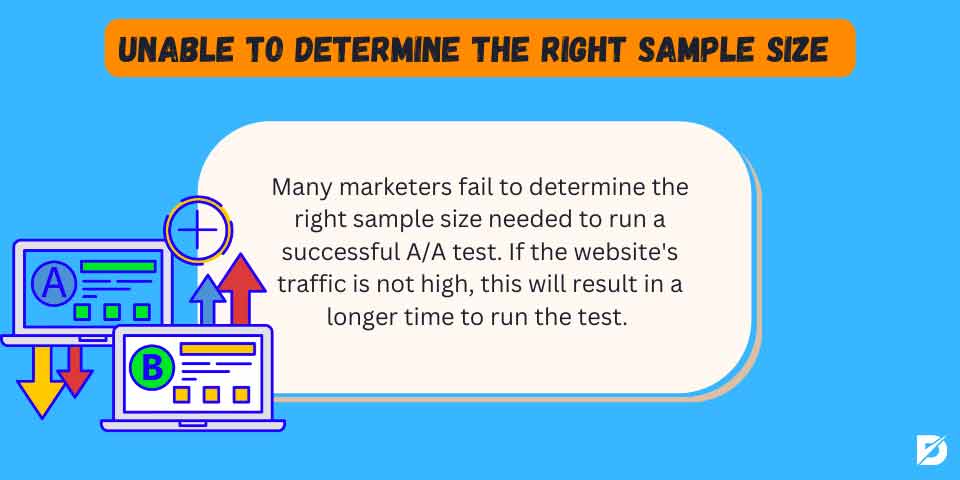
- Unable to Determine the Right Sample Size
Many marketers fail to determine the right sample size needed to run a successful A/A test. If the website’s traffic is not high, this will result in a longer time to run the test.
As a result, unfortunately, many marketers may end the test and conclude the result without reaching the right large sample size they must have. Ensuring an adequate sample size is crucial to detect even minor discrepancies accurately. Therefore, failure to do so will result in false data.
- Misinterpretation of Results
Organizations may misinterpret minor variations between identical variations as significant, leading to incorrect conclusions.
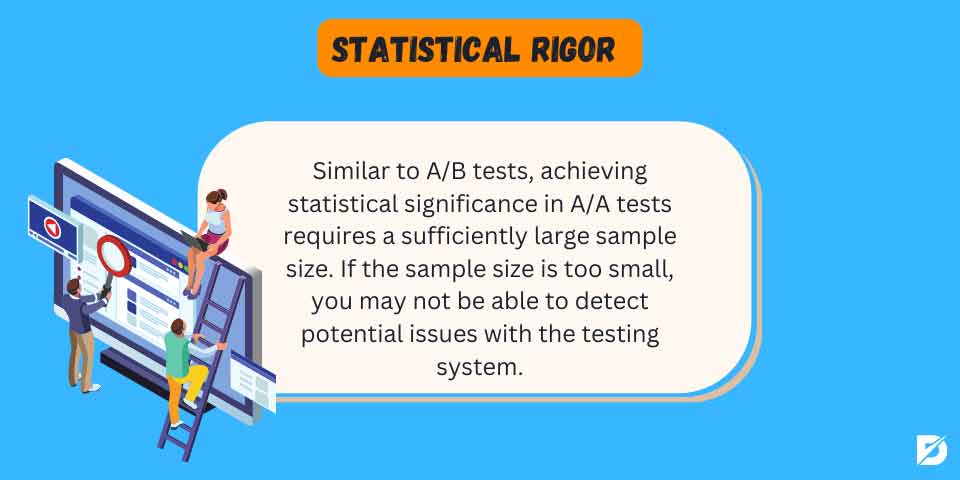
- Statistical Rigor
Similar to A/B tests, achieving statistical significance in A/A tests requires a sufficiently large sample size. If the sample size is too small, you may not be able to detect potential issues with the testing system.
Additionally, A/A testing still requires statistical rigor to differentiate between natural variability and actual issues.
- Resource Allocation
While A/A testing helps ensure accurate experimentation, it also consumes resources. Therefore, organizations need to balance effectively.
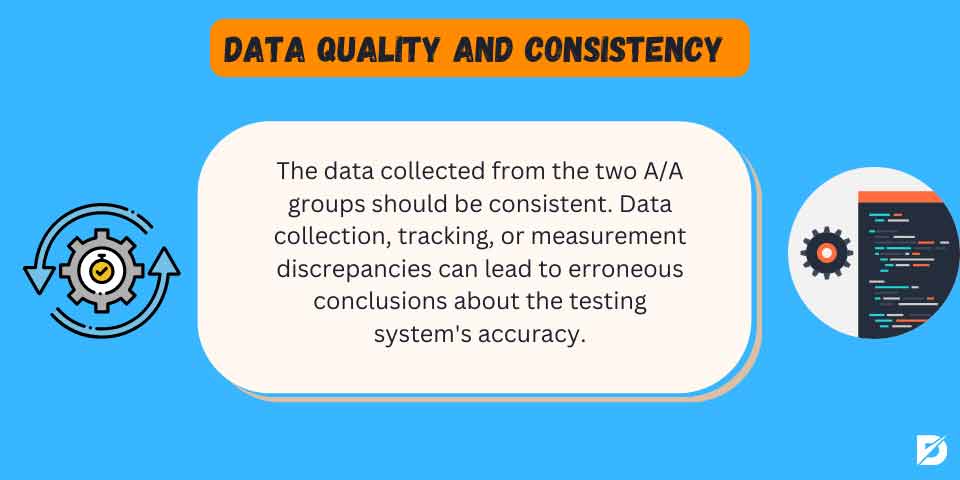
- Data Quality and Consistency
The data collected from the two A/A groups should be consistent. Data collection, tracking, or measurement discrepancies can lead to erroneous conclusions about the testing system’s accuracy.
- Segmentation and Variability
Variability in user behavior and other factors can lead to differences between the A/A groups that are not actually indicative of a problem with the testing system. It’s important to consider whether any observed differences are statistically meaningful or simply due to natural variation.
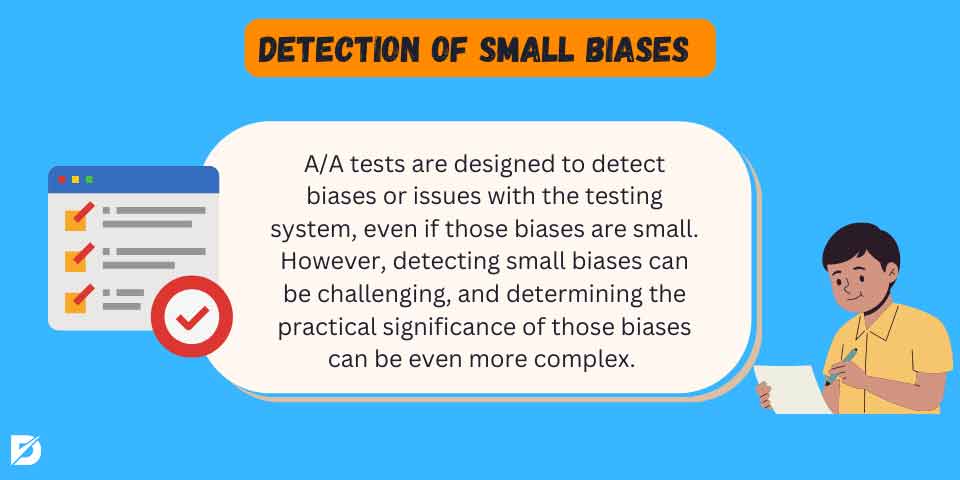
- Detection of Small Biases
A/A tests are designed to detect biases or issues with the testing system, even if those biases are small. However, detecting small biases can be challenging, and determining the practical significance of those biases can be even more complex.
- External Factors
Just like in A/B testing, external factors such as seasonality or changes in user behavior can impact the results of an A/A test. These factors need to be considered when interpreting the results.
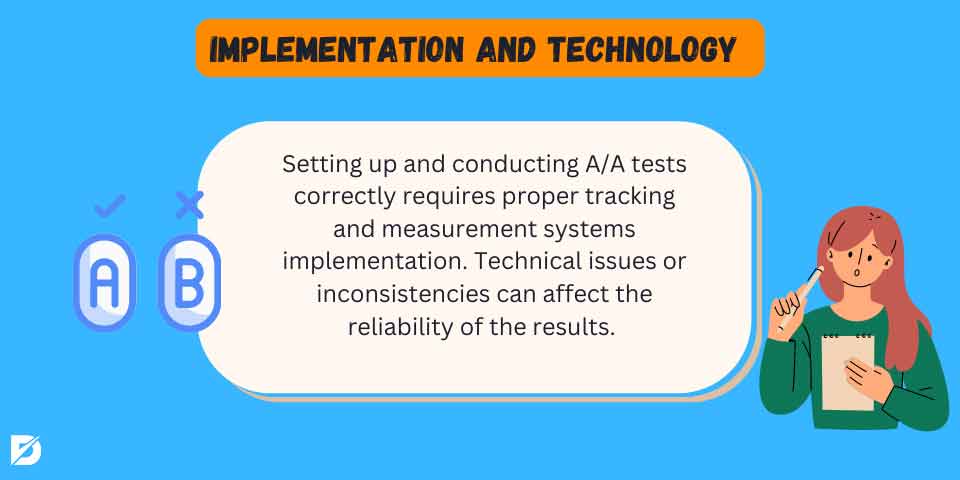
- Implementation and Technology
Setting up and conducting A/A tests correctly requires proper tracking and measurement systems implementation. Technical issues or inconsistencies can affect the reliability of the results.
- Interpretation and Actionability
Even if there is a bias or issue in an A/A test, interpreting the results and deciding on appropriate actions can be challenging. Determining whether a detected bias results from the testing system or a real issue with the user experience requires careful analysis.

- Time and Resources
While A/A tests are simpler than A/B tests, they still require time and resources to set up and monitor. Organizations need to allocate resources effectively to ensure accurate and meaningful results.
- Educational and Organizational Challenges
Ensuring that teams understand the purpose and limitations of A/A tests and can interpret the results correctly is crucial. Misinterpretations or lack of understanding can lead to incorrect conclusions.
Overall, A/A tests serve as a valuable tool to validate the accuracy and functionality of testing systems. Still, it’s essential to approach them with a clear understanding of the challenges involved and to interpret the results carefully.
Conclusion
A/A testing may be lesser-known than its counterpart, A/B testing, but its significance in ensuring accurate experimentation cannot be overstated. By comparing identical variations against each other, A/A testing serves as a valuable step in the experimentation process, helping organizations validate their testing infrastructure, evaluate data quality, and detect potential biases. While A/A testing doesn’t replace A/B testing, it sets the foundation for reliable and insightful experimentation, leading to data-driven decisions that optimize digital experiences and drive business success.
Frequently Asked Questions About
No, not really. Since A/A testing doesn’t require specialized tools, most experimentation platforms that support A/B testing can also facilitate A/A testing. Such tools are Google Optimize, Optimizely, and VWO. All offer functionalities to set up and analyze A/A tests alongside A/B tests.
To analyze A/A test results, compare the two identical variations’ performance metrics (such as conversion rates). If the differences are minimal and within the expected range of natural variability, it indicates that the testing infrastructure is functioning correctly. Significant differences could suggest biases or issues that need further investigation.
Yes, as A/A testing is relevant for all types of digital experiments that involve testing variations of a webpage or application element. Regardless of the experiment’s complexity, validating the experimentation setup through A/A testing helps ensure the reliability of the results.
No, A/A testing is not a replacement for A/B testing. While A/A testing is crucial for infrastructure validation and data quality assessment, A/B testing is crucial for optimizing user experiences and driving specific outcomes. Both testing methods serve different purposes and complement each other in the experimentation process.
The duration of an A/A test depends on factors like the website traffic volume, the measured metrics, and the level of statistical significance desired. Generally, running an A/A test for a few weeks can provide a sufficient amount of data to evaluate the accuracy of the testing infrastructure.





No comments to show.